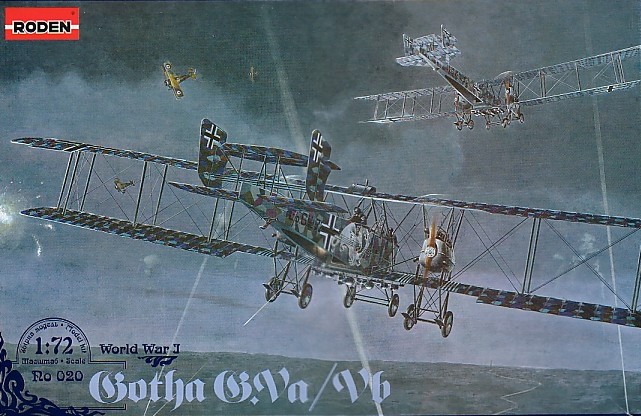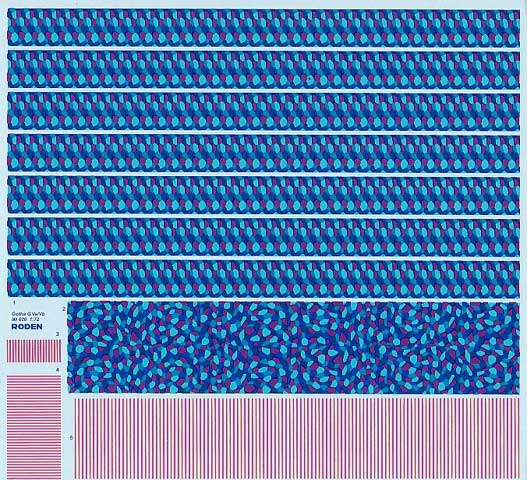|
Gotha G.Va/Vb

Roden
S
u m m a r y
|
| Catalogue Number: |
Kit No. 020 |
| Scale: |
1/72 |
| Contents and Media: |
149 grey plastic parts; 16 page
instruction booklet; decal options for six aircraft |
| Price: |
USD$20.97 from Squadron.com
|
| Review Type: |
FirstLook |
| Advantages: |
Superbly researched, accurate, well
moulded, restrained fabric detail. |
| Disadvantages: |
Lozenge a little bright, no Flettner
tabs. |
| Recommendation: |
Highly Recommended |
Reviewed by Robert Baumgartner

Roden's 1/72
scale Gotha Va/Vb is available online from Squadron.com
At last Roden have turned their attention to the
ultimate version in their Gotha series.
The G.Va/Vb came about due to Germany’s inability to
provide quality materials for the building of these aircraft. This meant
that poorer quality engines had to power heavier airframes, which created
an increase in engine failures. To fly a Gotha on one engine was not a
task that leads to a long life. The designers introduced a “box” tail to
allow the aircraft some measure of directional stability in such a
crisis.
It is this variant that Roden bring to our attention
with the release of the Gotha G.Va/Vb.
The Kit
This latest
incarnation of the Gotha series sees the addition of sprue C. As well as
containing the new tail surfaces, we also get the new fuselage halves that
are applicable to this version. Here we see the smaller nose gun turret
and associated revised profile. The tail surfaces are accurate with very
subtle rib detail and sharp trailing edges.
Sprue E is familiar and contains the engines, bombs,
wheels, struts and other items common to this and the previous G.V kit.
Attached is sprue F which presents the builder with the engine nacelles
(including those of the G.III/IV), propeller and basic undercarriage
parts. Depending on the option chosen, the other undercarriage parts can
be found on other sprues.
Click the
thumbnails below to view larger images:
Naturally with the smaller gun turret area, there
have to be a revised set of bulkheads and these are provided on sprue G.
Be careful not to lose the errata slip that tells you to use parts
31G and 32G instead of parts 26G and 28G. This sprue is also where the
Stossfahrgestell is found.
A major problem with the Gotha had always been its
stability when returning from its bombing raids. While the flight
characteristics with a full fuel and bomb load were very good, they left
much to be desired on the return trip. The lack of these items made the
aircraft tail heavy and unstable. Increasing the sweep back of the wing
helped to some extent but landing was always going to be a problem.
Naturally there were quite a few accidents, not least
being the overturning of the aircraft on landing, To help with this
problem, an extended wheeled frame was built to the nose of some
machines…the aforementioned Stossfahrgestell.
This centrally mounted undercarriage was first fitted
on the G.IVa. For those wanting to fit the four-wheeled variety that was
under each engine, Roden also supply this.
The wings are on sprue D and as in previous releases
they are superb. Rib detail is nicely restrained and it was pleasing to
see that the fabric effect on the surface has now been removed. There is a
little bit of flash present around some edges but this is easily removed.
The trailing edges are still nicely thin and the instructions correctly
show where to make the slight outline change to represent the G.V wing.
Surprisingly the kit omits the Flettner tabs on the
aileron trailing edges. Although they can be easily made with plastic
card, it is strange since this was a distinguishing feature of the
examples presented.
Sprue H contains the clear parts used for the
“windows” located in the fuselage.
All of the parts are very well moulded in a light
grey plastic. The detail is sharp and some of the smaller parts, such as
the struts, are scale thickness. Thus careful removal from the sprue is
needed here! The only place where the builder may have to fill an
ejection pin mark or smooth a blemish is inside the fuselage halves.
Experience has shown that despite the complexity of
the kit, it really isn’t as hard to put together as the number of parts
would suggest. The mounting of the top wing will always be the biggest
challenge but only because of the sheer number of struts. As for the
rigging, well that’s another story!
Marking Options
Three decal sheets are provided and my examples were
in perfect register.
A full compliment of lozenge is provided in both the
painted pattern for the fuselage and the printed fabric for the wings.
Roden have given their interpretation of the five
colours used but personally I would have liked to see a couple of
these shades a bit darker.

Two options are catered for, these being:
a)
Gotha G.Va 723/17 Boghol 3 1918.
This interesting aircraft
was captured in France on July 5 1918. The fuselage wears a fire-spitting
dragon which Roden supply as white on the decal sheet. A photo reveals
that this marking was indeed coloured so the modeler will have to shade
this appropriately. Don’t worry if the fuselage lozenge shows through this
decal as the original aircraft displayed this characteristic. Roden show
this correctly on the instruction sheet.
b)
Gotha G.Vb 917/18, 1918
This aircraft was
photographed clearly displaying the Flettner servo controls mentioned
earlier. Although not supplied, it’s nothing a little plastic card
couldn’t fix. The box top illustration will provide a guide here.

As expected Roden
have continued where they left off with the previous Gotha kits. Here we
have a well-engineered kit that gives the builder a realistic chance of
completing a model of a very complicated subject.
Having been impressed with their earlier efforts of
this famous bomber, it is pleasing to find that this release does not
disappoint.
Full marks to Roden
for tackling one of the most interesting bombers of WWI.
Highly recommended.
Thanks to
Squadron.com for the review
sample.
Review and Images Copyright © 2003 by
Robert Baumgartner
Page Created 03 December, 2003
Last updated 03 December, 2003
Back to HyperScale Main Page
Back to Reviews Page
|
Home | What's
New | Features
| Gallery |
Reviews | Reference
| Forum
| Search